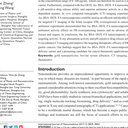Analysis of the herbicidal mechanism of 4-hydroxy-3-methoxy cinnamic acid ethyl ester using iTRAQ and real-time PCR.
Keywords
Abstract
Absolute quantitation (iTRAQ) is the latest development in the new quantitative proteomics technology for high-throughput identification and quantitation of proteins. The mechanisms underlying the 4-hydroxy-3-methoxy cinnamic acid ethyl ester treatment in Arabidopsis thaliana was investigated. Deficiency-induced changes in the protein profile of A. thaliana caused by this compound were analyzed using iTRAQ and quantitative real-time PCR. A total of 2909 proteins were quantified, of which 49 and 34 proteins were upregulated and downregulated, respectively, in the experimental plants compared with the controls. Treatment results showed that numerous proteins were involved in photosystemII, energy metabolism, and cell structure formation. Based on the upregulated and downregulated proteins, high amount of AT4G21280 protein acted on the oxygen-evolving enhancer protein 3-1, while low amount of AT1G10340 protein affected the catabolic process of the photosystemII-associated light-harvesting complex II. We selected these proteins to preliminarily verify the expression of proteins using quantitative real-time PCR to provide a reliable basis for further studies after proteomics analysis. Results show that the combined use of iTRAQ and quantitative real-time PCR provides an effective method to study proteins, leading to the determination of a new herbicide mechanism.


